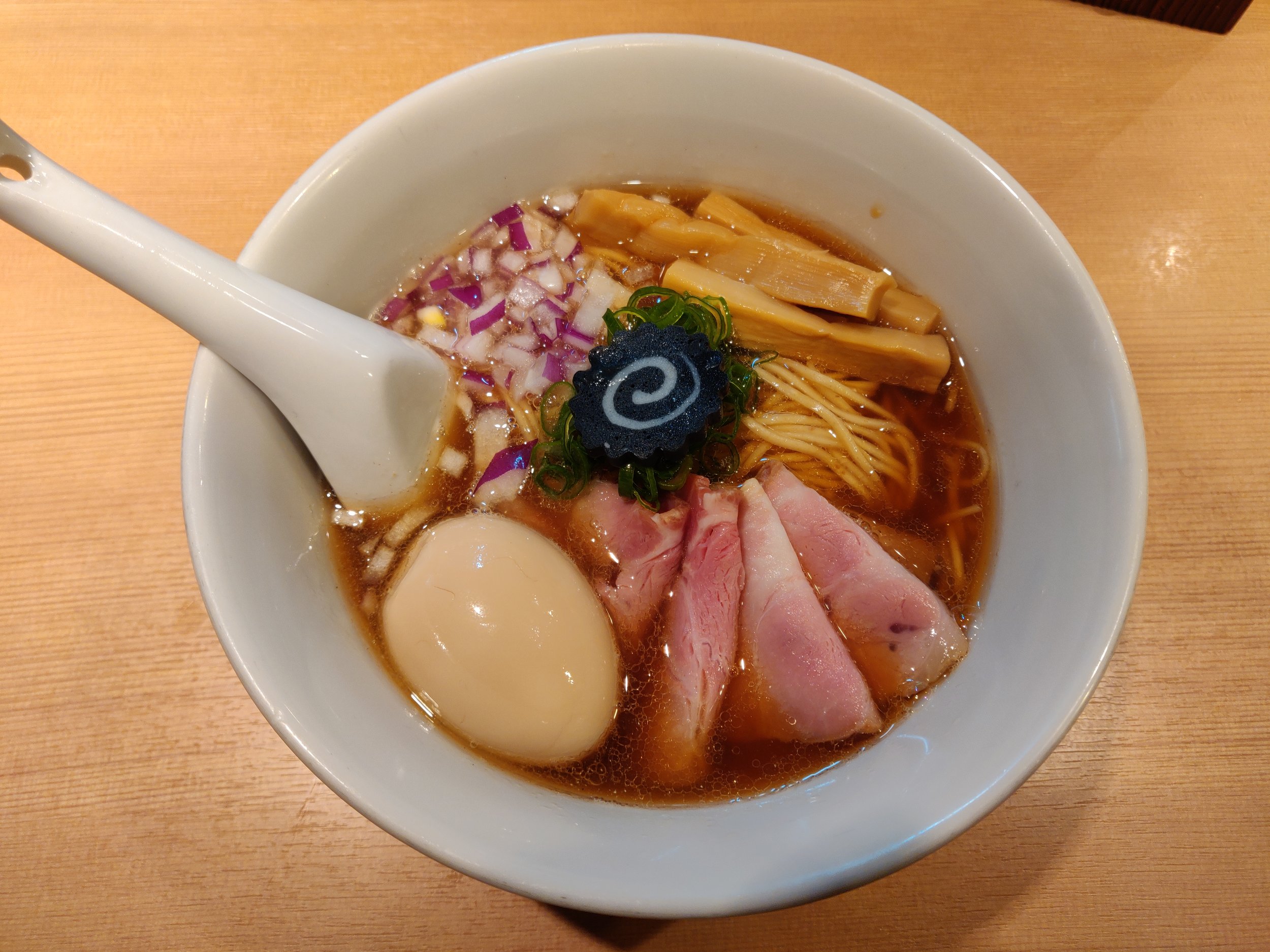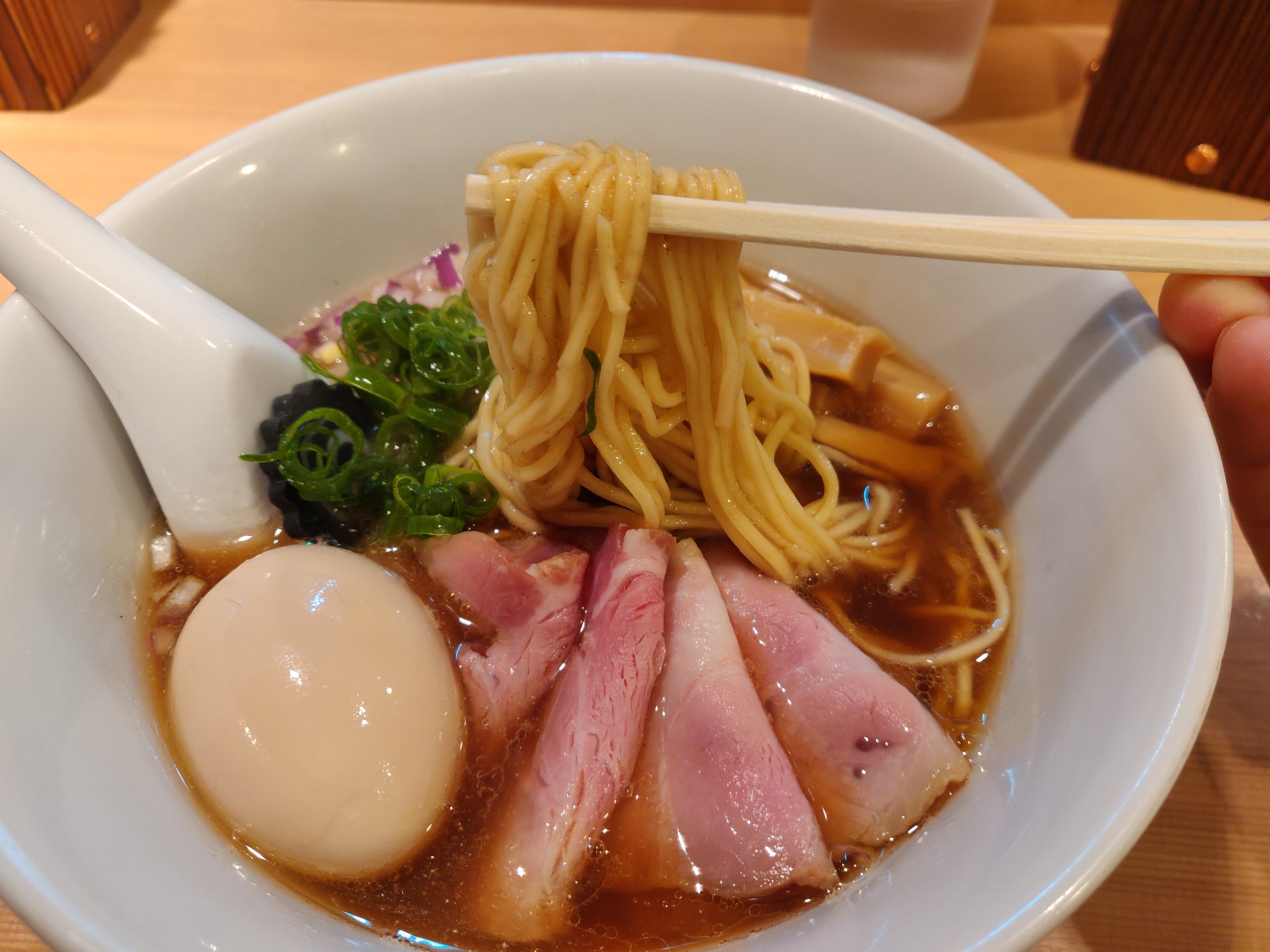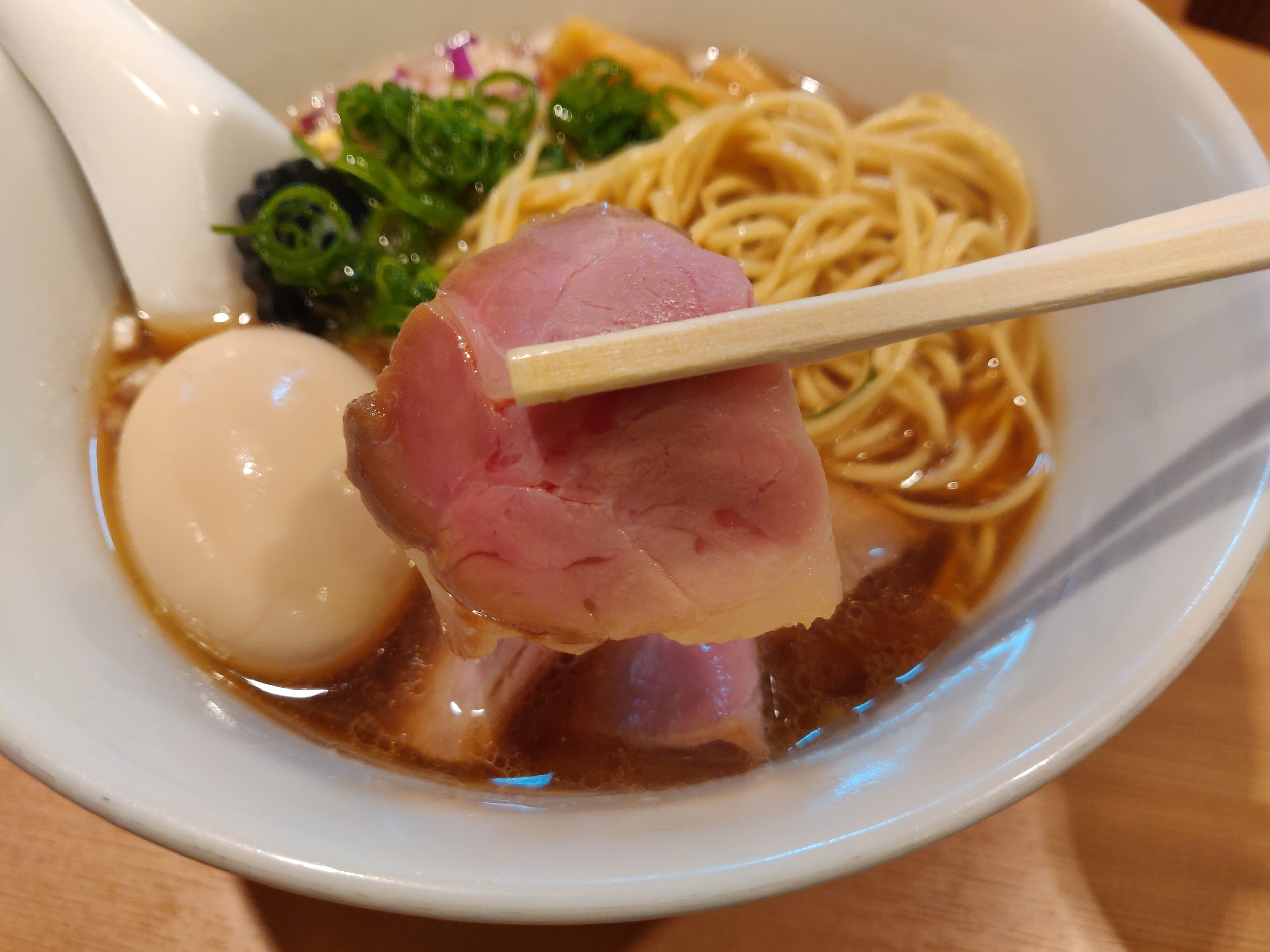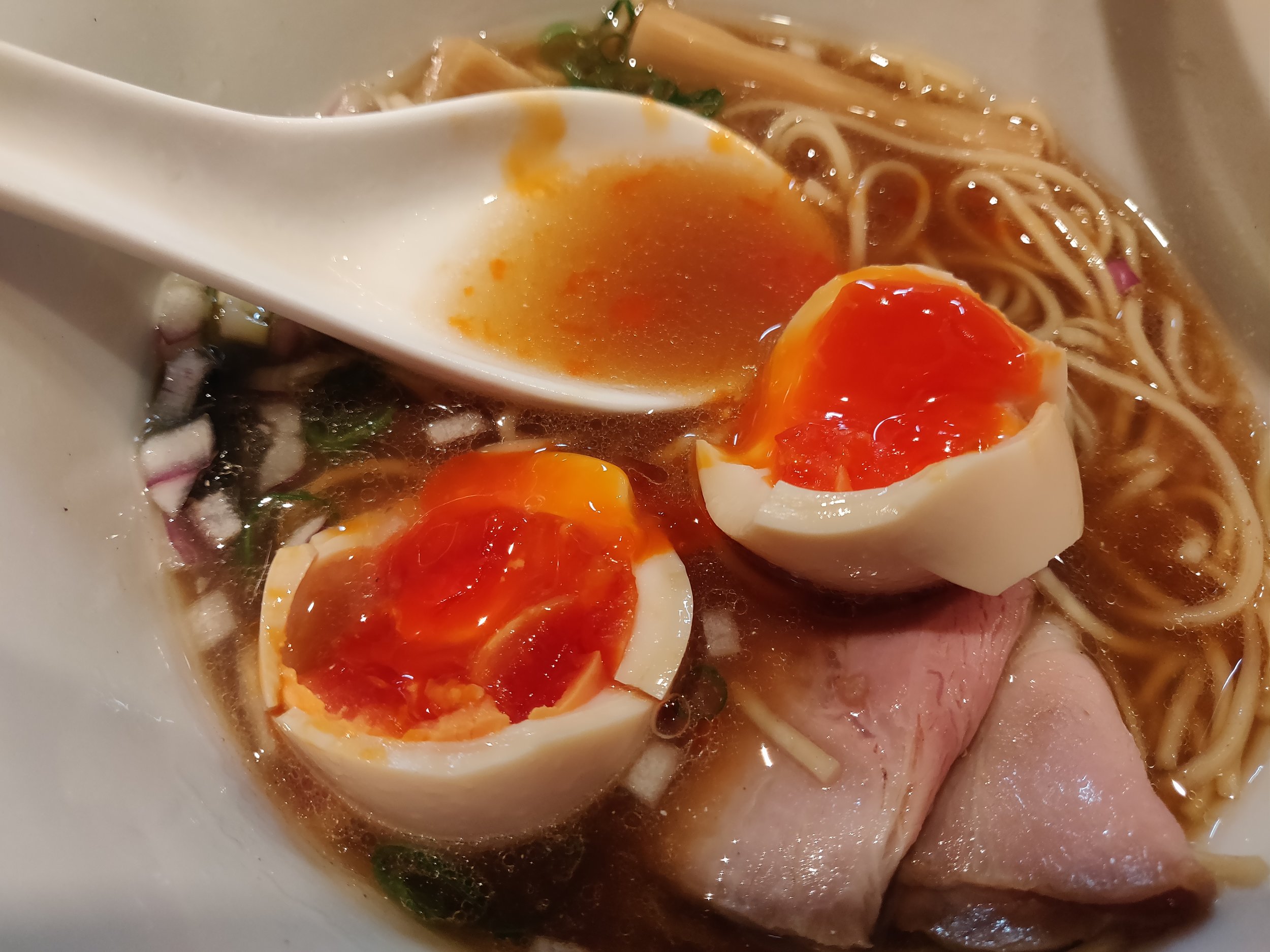Ramen Hayashida (らぁ麺 はやし田); Best in Shinjuku?, Shinjuku
Shinjuku has long been known as the mecca of ramen with many owners arguing that if you can make it in Shinjuku, you can make it anywhere. Competition is incredibly fierce as established franchises to boutique, specialty shops and more local mom and pop shops all fight for Shinjuku ramen real estate. More recently, newly crowned Michelin One Star restaurant, Konjiki Hototogisu moved their shop to the competitive Shinjuku location creating more buzz and foot traffic from western media and tourists. However, from the hundreds of thousands of shops in the area, one has really stood out for me as my favorite. Ramen Hayashida, located a few minutes away from Kabukicho, has been churning out a duck and chicken broth based ramen since 2017, but has recently started producing a seafood broth based ramen using the famous Nodoguro. Nodoguro, or Blackthroat Seaperch, is a variety of sea bass with a high fat content and tender texture. The fish is primarily served sashimi or braised, but Hayashida has figured out a way to pull a delicious broth from the Nodoguro to make an amazing, limited serving, seafood ramen bowl that is worth every minute of waiting time in the queue. If I can recommend just one ramen in Shinjuku, the Nodoguro Soba definitely takes the cake.
Open 7 days a week (with some holidays off), Hayashida is the few ramen shops that do not have a set day off every week. For lunch, Hayashida is open from 11:00-16:00 and 18:00-22:00 for dinner. The most popular menu item is definitely the regular Shoyu Ramen on the first row, but Hayashida also serves a Tsukemen located on the third row. The Nodoguro Soba, which is limited to about 60 servings a day (40 for lunch, 20 for dinner), located on the fourth row is by far, for me, one of the best soups of a ramen I have ever had. For each ramen variety, the buttons are organized from regular ramen on the left, followed by the Ajitama Ramen with a marinated soft boiled egg, then Tokusei Ramen with all the toppings, and extra noodles for 100 yen to the far right. The fifth row is the Tantanmen, with a Maze soba right below. The last three rows are the rice sets, toppings, and beer. For rice you have the option for Ochazuke (Japanese porridge) or regular rice. The toppings start with extra char siu, then marinated egg, and finally extra menma bamboo shoots. For the beers you can choose between regular beer or a specialty, craft beer. As for the Nodoguro Soba, while they only serve 60 a day, its hard to predict whether they will still have some by the time you arrive. For lunch, I would say that any time before 12:00 will guarantee you a bowl on weekends, and any time before 12:30 on weekdays. Dinner has even less servings and so I would suggest arriving before 18:30 regardless of the day to ensure a bowl. Again, this is just my estimate based on the times I myself was able to enjoy a bowl so take it with caution. If your mind is definitely set on the Nodoguro Soba, I would recommend just showing up at their opening times.
As it is my favorite, this review will be strictly on the Nodoguro Soba (with a review of the other varieties to come in a later review). Upon first glance, the soup for Hayashida’s Nodoguro Soba looks like a typical, shoyu ramen. A golden, brown hue glows from their shoyu blend, and a thin layer of fat and oil float right above the surface. As you finally scoop a ladle of soup in to your mouth, you’ll realize the vast difference between a typical chicken and duck based shoyu ramen and this fish based one. The initial taste of the fat and oil is a lot more delicate than one you’d find in an animal based ramen. Most bird based oils and fats used for ramen have a rather strong, savory, and thick tasting notes which leave a nice coating of oil in your mouth. The fish however is a bit more subtle, and washes away quickly in your mouth, but the initial flavor punch is very powerful. After tasting the initial bit of Nodoguro fat, you’ll begin tasting the sweetness the fish tends to bring. If you’ve ever had a braised Nodoguro, you might already know, but Nodoguro is known for a bit of a sugary flavor making a lot of their shoyu braised dishes taste similar to a teriyaki even though not much sugar besides mirin is added. Hayashida balances this sweetness with a pronounced umami flavor from the Konbu (seaweed) stock and a salty, shoyu blend for the tare. What results is, for me, the perfect balance of salty, savory, and sweet in one bowl.
The noodles here are fantastic, made specifically for the store and has a bit of wheat mixed throughout.The wheat noodles produced a bit of an old, roasted aftertaste that I felt matched perfectly with the Nodoguro soup. They have a traditional straight, thin shape and gives just the right ratio of noodle to soup when you slurp so it doesn’t overpower the gentle broth. The pork char siu is the ever popular sous vide style with a nice rosy pink finish. Hayashida leaves a bit of fat around the edges which gives it a nice balance of meatiness and fat. I appreciated that it wasn’t overly fatty or flavorful as it didn’t muddle the ramen flavors. The black, naruto fish cake you see is made with the Nodoguro meat. If you didn’t already know by the English name, the name of the fish derives from its unique black throat; nodo is Japanese for throat and guro is black. Hence when making their Naruto, fish cakes, Hayashida kept the Nodoguro trademark and colored them black. The fish cake is incredibly flavorful and they have a very pronounced fishiness to them. A lot of ramen restaurants would usually use a bit of charred fish flakes as topping, but I thought the uniqueness of making their own naruto fish cakes was an excellent touch. Both the green onions and red onions gave the bowl a nice refreshing crunch and palette cleansing between bites while the egg was soft and gooey, adding a second life of creaminess to the soup as you finish up your bowl.
Of course, I’m being incredibly biased here as I am a huge lover of seafood based broths. While its not necessarily an acquired taste, it is a taste that might not be suitable for people who haven’t eaten a ton of seafood. Again, this is a pretty light bowl of ramen in comparison to may be a tonkotsu ramen or a traditional tsukemen, so if thats what you’re looking for, Hayashida is not for you. BUT, if you want to try something a bit further from the norm, and with very high end ingredients, I strongly suggest checking out Hayashida. As always, if you end up going to Hayashida let me know via Facebook, Instagram, Twitter or right here in the comment section below what you thought. I would love hearing from all of you and get to know your thoughts and opinions.





